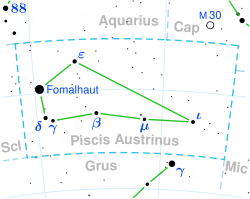みなみのうお座ベータ星
| みなみのうお座β星 β Piscis Austrini | ||
|---|---|---|
| 星座 | みなみのうお座 | |
| 見かけの等級 (mv) | 4.29[1] | |
| 位置 元期:J2000.0 | ||
| 赤経 (RA, α) | 22h 31m 30.3305233469s[2] | |
| 赤緯 (Dec, δ) | −32° 20′ 45.871070532″[2] | |
| 視線速度 (Rv) | 5.05 ± 0.14 km/s[2] | |
| 固有運動 (μ) | 赤経: 58.640 ミリ秒/年[2] 赤緯: -18.857 ミリ秒/年[2] | |
| 年周視差 (π) | 22.0836 ± 0.2117ミリ秒[2] (誤差1%) | |
| 距離 | 148 ± 1 光年[注 1] (45.3 ± 0.4 パーセク[注 1]) | |
| 絶対等級 (MV) | 1.0[注 2] | |
みなみのうお座β星の位置(赤丸)
| ||
| 物理的性質 | ||
| 半径 | 2.32 R☉[3] | |
| 質量 | 2.34 M☉[3] | |
| 表面重力 (log g) | 4.3 cgs[4] | |
| 自転速度 | 30 km/s[5] | |
| スペクトル分類 | A0 V[1] | |
| 光度 | 31.58 L☉[3] | |
| 有効温度 (Teff) | 9,599 K[4] | |
| 色指数 (B-V) | 0.01[1] | |
| 色指数 (U-B) | 0.02[1] | |
| 色指数 (R-I) | 0.02[1] | |
| 金属量[Fe/H] | 0.00[6] | |
| 年齢 | 1.80 ×108 年[7] | |
| 他のカタログでの名称 | ||
| みなみのうお座17番星, CD-32 17126, FK5 1592, HD 213398, HIP 111188, HR 8576, SAO 213883[2] | ||
| ■Template (■ノート ■解説) ■Project | ||
みなみのうお座β星(みなみのうおざベータせい、β Piscis Austrini、β PsA)は、みなみのうお座で4番目に明るくみえる恒星である[8]。見かけの等級は4.29と、肉眼でみえる明るさである[1]。年周視差に基づいて太陽からの距離を計算すると、約148光年となる[2][注 1]。重星として知られ、1つの伴星と固有運動を共有する連星系であると考えられる[8][9]。
特徴
[編集]| 太陽 | みなみのうお座β星 |
|---|---|

|

|
みなみのうお座β星は、同じみなみのうお座で突出して明るいフォーマルハウトと似た、白色に輝くA型主系列星で、スペクトル型はA0 Vと分類される[8][1]。表面の有効温度はおよそ9,600 K、光度は太陽の32倍程度で、半径は太陽の約2.3倍、質量も太陽の約2.3倍と推定されている[3]。年齢は等年齢線に基づいて約1億8千万年と求められ、主系列寿命の3分の1程度しか消化していないとみられる[7][8]。
星周円盤
[編集]みなみのうお座β星では、遠赤外域で顕著な赤外超過が検出されており、残骸円盤が存在するものとみられる[10]。円盤の構造は、塵の温度が190 K程度の温かい円盤が、中心星から半径12 au辺りに広がり、その塵の質量は地球の0.013パーセント程度、塵の温度が60 K程度の冷たい円盤が、中心星から111 au辺りに広がり、その塵の質量は地球の0.63パーセント程度と推定される[3]。
星系
[編集]| CD-32 17127 | ||
|---|---|---|
| 見かけの等級 (mv) | 7.04[11] | |
| 物理的性質 | ||
| 質量 | 1.04 M☉[12] | |
| 自転速度 | 6.3 km/s[11] | |
| スペクトル分類 | G1 V[11] | |
| 有効温度 (Teff) | 6025.6 K[13] | |
| 地球から見た位置 (みなみのうお座β星との関係) | ||
| 角距離 | 30.3 秒[9] | |
| 軌道要素と性質 | ||
| 公転周期 (P) | 8.94 ×106 日[9] | |
| 他のカタログでの名称 | ||
| SAO 213884[14] | ||
| ■Template (■ノート ■解説) ■Project | ||
みなみのうお座β星には、19世紀にジュゼッペ・ピアッツィが発見した7等星の「伴星」が存在する[15]。南に30.3秒角離れた位置にある、CD-32 17127がそれである[15][9][14]。発見されたとき、伴星はもっと離れた位置にみえており、2つの恒星が太陽から等距離であったとしても、1500 au以上離れているので、連星ではないとも考えられていた[8][15]。
しかし、固有運動を分析したところ、2つの恒星は同じ運動を共有していることがわかり、物理的に結びついた連星であるとする説を支持する結果となった[12]。連星であるとすれば、公転周期は2万4千年を超えるものとみられる[9]。伴星の質量は、太陽とほぼ同じで、スペクトル型はG1 Vと推定されている[12]。
脚注
[編集]注釈
[編集]出典
[編集]- ^ a b c d e f g Hoffleit, D.; Warren, W. H., Jr. (1995-11), “Bright Star Catalogue, 5th Revised Ed.”, VizieR On-line Data Catalog: V/50, Bibcode: 1995yCat.5050....0H
- ^ a b c d e f g h “bet PsA -- High Proper Motion Star”. SIMBAD. CDS. 2023年7月21日閲覧。
- ^ a b c d e Gáspár, András; Rieke, George H.; Ballering, Nicholas (2016-08), “The Correlation between Metallicity and Debris Disk Mass”, Astrophysical Journal 826 (2): 171, Bibcode: 2016ApJ...826..171G, doi:10.3847/0004-637X/826/2/171
- ^ a b Draper, Zachary H.; et al. (2018-04), “A-type Stellar Abundances: A Corollary to Herschel Observations of Debris Disks”, Astrophysical Journal 857 (2): 93, Bibcode: 2018ApJ...857...93D, doi:10.3847/1538-4357/aab1fd
- ^ Royer, F.; et al. (2002-01), “Rotational velocities of A-type stars. I. Measurement of v sin i in the southern hemisphere”, Astronomy & Astrophysics 381: 105-121, Bibcode: 2002A&A...381..105R, doi:10.1051/0004-6361:20011422
- ^ Lemke, M. (1989-11), “Abundance anomalies in main sequence A stars. I. Iron and titanium”, Astronomy & Astrophysics 225: 125-136, Bibcode: 1989A&A...225..125L
- ^ a b Vican, Laura (2012-06), “Age Determination for 346 Nearby Stars in the Herschel DEBRIS Survey”, Astronomical Journal 143 (6): 135, Bibcode: 2012AJ....143..135V, doi:10.1088/0004-6256/143/6/135
- ^ a b c d e Kaler, James B. (2009年12月11日). “BETA PSA (Beta Piscis Austrini)”. Stars. University of Illinois. 2023年7月21日閲覧。
- ^ a b c d e Rodriguez, David R.; et al. (May 2015-05), “Stellar multiplicity and debris discs: an unbiased sample”, Monthly Notices of the Royal Astronomical Society 449 (3): 3160-3170, Bibcode: 2015MNRAS.449.3160R, doi:10.1093/mnras/stv483
- ^ Gáspár, András; Rieke, George H.; Balog, Zoltán (2013-05), “The Collisional Evolution of Debris Disks”, Astrophysical Journal 768 (1): 25, Bibcode: 2013ApJ...768...25G, doi:10.1088/0004-637X/768/1/25
- ^ a b c Torres, C. A. O.; et al. (2006-12), “Search for associations containing young stars (SACY). I. Sample and searching method”, Astronomy & Astrophysics 460 (3): 695-708, Bibcode: 2006A&A...460..695T, doi:10.1051/0004-6361:20065602
- ^ a b c Waisberg, Idel; Klein, Ygal; Katz, Boaz (2023-06), “Binarity and beyond in A stars - I. Survey description and first results of VLTI/GRAVITY observations of VAST targets with high Gaia-Hipparcos accelerations”, Monthly Notices of the Royal Astronomical Society 521 (4): 5232-5254, Bibcode: 2023MNRAS.521.5232W, doi:10.1093/mnras/stad872
- ^ Cruzalèbes, P.; et al. (2019-12), “A catalogue of stellar diameters and fluxes for mid-infrared interferometry”, Monthly Notices of the Royal Astronomical Society 490 (3): 3158-3176, Bibcode: 2019MNRAS.490.3158C, doi:10.1093/mnras/stz2803
- ^ a b “CD-32 17127 -- High Proper Motion Star”. SIMBAD. CDS. 2023年7月21日閲覧。
- ^ a b c Mason, Brian D.; et al. (2023-05), “The Washington Visual Double Star Catalog”, VizieR Online Data Catalog, Bibcode: 2023yCat....102026M
関連項目
[編集]外部リンク
[編集]- “β Piscis Austrini”. alcyone software. 2023年7月21日閲覧。
